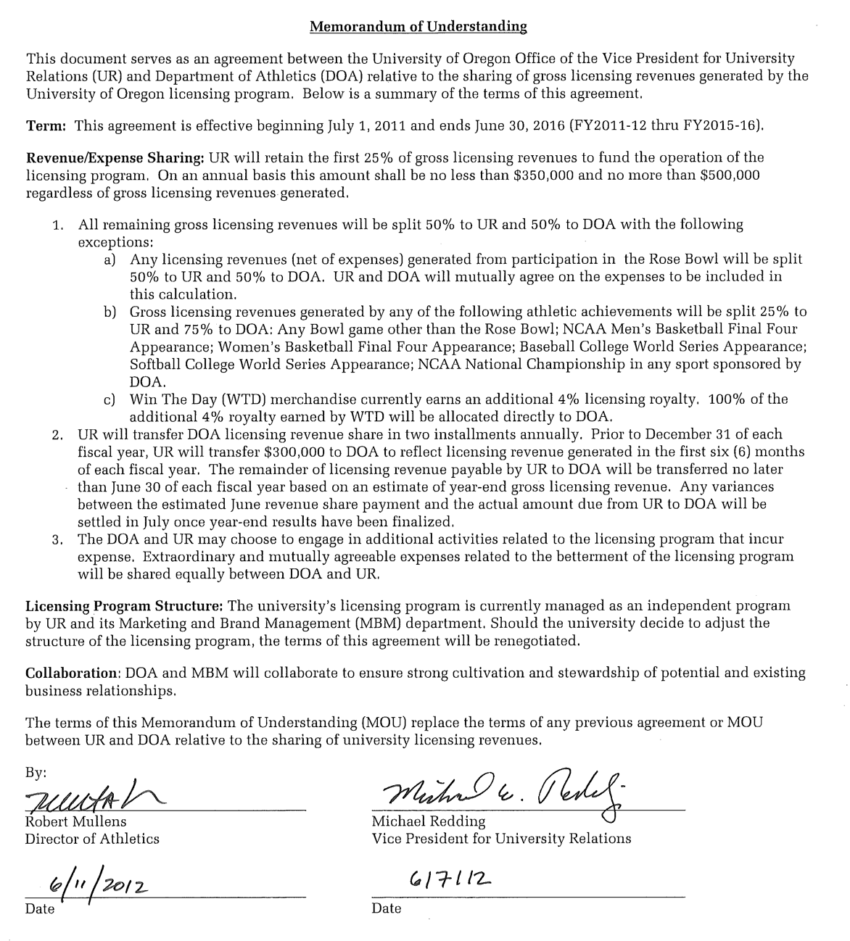Scott Coltrane started the first search to replace GC Randy Geller. That didn’t yield anyone better than Doug Park, as explained here. So Mike Schill sensibly started over, offering more responsibility and much higher pay. Job ad here. Finalist #3 was a keeper:
Finalist #3 for GCVP: Kevin S. Reed, UCLA. Schedule for Aug 5 visit here, resume and cover letter here:

And now Diane Dietz – not exactly known for her fawning stories about UO’s lawyers – has a report about AGC Dearinger and GC Reed’s success at renegotiating the Duck’s media contract, for 40% more money:
Deciding the Duck athletics brand is worth much more than the Athletics Department was getting from its multi-media licenser, the UO reopened negotiations in the middle of its 10-year contract — and scored.
Now, IMG College has agreed to pay the Ducks at least $57 million over the next six years, and maybe considerably more, depending on how royalties stack up. That’s at least a 40 percent boost from the old contract.
“For the last few years, we’ve been way undervalued in our old deal,” athletics Director Rob Mullens told the UO Board of Trustees on Thursday.
… UO General Counsel Kevin Reed reviewed the proposed contract.
Reed worked at the University of California-Los Angeles last year when it negotiated a 10-year contract extension with IMG worth $150 million.
And, under the terms of the MOU between UO and the Duck Athletic Department, the academic side actually gets to keep some of that money. Not enough to offset the damage that Dana Altman has done to the UO brand – much less the $2.5M Jock Box subsidies, the $350K the Ducks charge Mike Schill to use the Autzen skybox, or the Knight Arena bond scheme, but when we’re laying off history faculty, every little bit counts:

The deal expires at the end of this month though. Gottfredson’s chief of staff Greg Rikhoff went through a lot of machinations to conceal the terms of the previous MOU – which I was told was a better straight 50/50 deal – and to avoid explaining what had happened to the $100K that the Jocks used to give to the UO Library. My efforts to get this info was one of the reasons Gottfredson told Rob Mullens he could stop meeting with the Senate IAC – too many hard questions. Emails with Rikhoff are here. I’ll see if I can get the new MOU.
I am not sure whether to be shamed or flattered by favorable mention on uomatters, but in this instance I need to protest that it is inaccurate. The IMG contract and its capture of revenues for UO was a team effort, and Rob Mullens and Eric Roedl drove the hard bargain — AGC Bryan Dearinger was the skilled draftsman. This is the only time I have ever felt compelled to comment on the blog, and I do so only to make the narrow point that you need to stop maligning Roedl, whose undeniable skill has led to these kinds of successes, which, in turn, has made Duck athletics a national brand that UO academics can unquestionably build upon.
I’m glad to hear that Eric Roedl and Rob Mullens helped drive a hard bargain with IMG. They sure drove a hard one with our students last year, over the ~$1.7M (~$71 per student) in mandatory fees they must pay to Mullens and Roedl for the football ticket lottery.
Here’s the letter to the Daily Emerald, written by UO undergrad and Truman Scholar Andrew Lubash, and signed by 13 other ASUO student Senators, and 3 ACFC members: http://www.dailyemerald.com/2015/02/20/guest-viewpoint-asuo-senate-acfc-respond-to-athletics-threat/
… Out of the $15 million ASUO budget, students spend $1,695,348 paying for the football and men’s basketball ticket lottery. This comes down to about $71 per year that students pay through their mandatory fees for the chance to go to our athletic events. We, the undersigned, think this is too high. …
However, when the ASUO began negotiating with the Athletics Department this year, we were surprised to find out that not only was there absolutely no chance they were going to give us more tickets, they were requesting $169,000 more from students than last year, for the same number of tickets. A 10% increase!
We were infuriated.
Now, they say that they will likely begin cutting student football tickets if we don’t give them at least a 3% increase (~$50,000). Their actions are greedy and deplorable. They’re acting like a business focused solely on profit, when they should be working towards supporting the academic side of this university. Why isn’t there an expectation on our campus that athletics give back to students? Students aren’t even guaranteed a ticket.
… After an article came out in the Register Guard saying that the Athletic Director would fundraise millions in order to pay for his own salary increases ($700,000/year) and those of other Athletic department staff, we had had enough. We find it fundamentally unfair that the Athletic Department can find it within their hearts to fundraise for themselves, yet they resort to threatening to cut student tickets if the ASUO does not give them their requested increase. Is it actually that hard for them to raise $50,000 on top of the millions they already plan to raise? We don’t think so.
… At some point, someone needs to stand up and shine a light on the enormous difference that exists between what the Athletic Department deems as “necessary” and what students deem as excessive. Many of us struggle to afford our education as it is. We should not stand for our own Athletic Department to treat us as another lucrative source of funds to line their own pockets with. It’s time for them to start giving back and support students of all financial backgrounds. …
[Signed by 17 Student Senators, etc.]
I hate to ask a question about something that is unquestionable, but I feel like the case that the academic benefit of building a national athletics brand is something often asserted but not specifically substantiated. Can anyone bring clarity to the issue?
Other than that, I appreciate Kevin’s willingness to post here and share credit.
Once upon a time the NCAA commissioned a report on the “Empirical Effects of Collegiate Athletics”. The 2003 report is here: https://www.ncaa.org/sites/default/files/empirical_effects_of_collegiate_athletics_interim_report.pdf and the 2005 update is here: https://www.ncaa.org/sites/default/files/empirical_effects_of_collegiate_athletics_update.pdf For reasons that will be obvious after reading these, the NCAA is no longer sponsoring independent research on this subject:
Hypothesis #8: Increased operating expenditures on sports affect measurable academic quality in the medium term.
• Our statistical analysis suggests no relationship – either positive or negative – between changes in operating expenditures on football or basketball among Division I-A schools and incoming SAT scores or the percentage of applicants accepted….
But there’s been a lot of empirical work on related topics since. Here’s a replication of the famous paper by UO economist Glen Waddell, showing that Duck football wins hurt student grades: http://www.sciencedirect.com/science/article/pii/S0272775714000806
Here’s a paper by TAMU economist Jason Lindo, showing college football games mean more rapes, at http://www.nber.org/papers/w21828:
This paper considers the degree to which events that intensify partying increase sexual assault. Estimates are based on panel data from campus and local law-enforcement agencies and an identification strategy that exploits plausibly random variation in the timing of Division 1 football games. The estimates indicate that these events increase daily reports of rape with 17–24 year old victims by 28 percent. The effects are driven largely by 17–24 year old offenders and by offenders unknown to the victim, but we also find significant effects on incidents involving offenders of other ages and on incidents involving offenders known to the victim.This paper considers the degree to which events that intensify partying increase sexual assault. Estimates are based on panel data from campus and local law-enforcement agencies and an identification strategy that exploits plausibly random variation in the timing of Division 1 football games. The estimates indicate that these events increase daily reports of rape with 17–24 year old victims by 28 percent. The effects are driven largely by 17–24 year old offenders and by offenders unknown to the victim, but we also find significant effects on incidents involving offenders of other ages and on incidents involving offenders known to the victim.
Another interesting paper is Anderson (forthcoming): https://are.berkeley.edu/~mlanderson/pdf/Anderson%20College%20Sports.pdf
If you just read the abstract you’ll think that big-time sports helps the academic side. But that’s not the conclusion. Even if you ignore the rapes and decreased grades, The estimated benefits aren’t worth the cost:
Do these effects imply that investing in team quality generates positive net benefits for an FBS school? Answering this question is difficult because we do not know the causal relationship between team investments and team wins. Nevertheless, we consider a simple back-of-the-envelope calculation to establish the potential return on team investments.
Orszag and Israel (2009) report that a $1 million increase in “football team expenditures” is associated with a 6.7 percentage point increase in football winning percentage (0.8 games). If we interpret this relationship as causal, it implies that a $1 million investment in football team expenditures increases alumni athletic donations by $109,000, increases annual applications by 108, and increases the average incoming SAT score by 0.6 points. These effects seem too modest by themselves to justify the additional expenditures. However, if increases in team expenditures generate commensurate increases in athletic revenue (another finding in Orszag and Israel (2009), though a portion of this relationship is surely due to reverse causality), then the effects estimated here represent a “bonus” that the school gets on top of the increased athletic revenue.
Here are some additional references:
Big-time college sports should split from their universities
http://www.latimes.com/business/hiltzik/la-fi-hiltzik-20150320-column.html
https://sports.vice.com/en_us/article/four-years-a-student-athlete-the-racial-injustice-of-big-time-college-sports
http://www.nytimes.com/2012/01/22/education/edlife/how-big-time-sports-ate-college-life.html?_r=0
https://www.insidehighered.com/quicktakes/2016/05/19/study-big-time-college-sports-neglect-academics-deflect-blame (May 2016)
http://www.washingtonpost.com/sf/sports/wp/2015/11/23/running-up-the-bills/ –this one is a most read